Early last January at the Hotel Donaldson in downtown Fargo, I promised to write something to convince a friend, John Lamb, of the reasonableness of the claim that the Coen brothers are sometimes unsympathetic to their on-screen subjects. I don't know that I can present an airtight case for the claim, but I'll kick the idea around for a while and see what happens.
I first heard the claim a few years ago at the University of Colorado, during a "Cinema Interruptus" -- a viewing of a film during which anyone in the audience can yell "stop" at any time in order to air a comment or question -- hosted by Roger Ebert. There were five sessions. On Monday we watched Fight Club from beginning to end, no interruptions. From Thursday to Friday we watched it again, interruptions allowed, for an hour or so each day. (Ebert's been doing this every year for a while. The schedule for that event isn't online, but last year's is [PDF].)
Anyway, that week Ebert mentioned that some people have criticized the Coen brothers for lacking sympathy for their characters. I think he said it during the scene in which The Narrator, Edward Norton's character, beats the blond character to a bloody pulp and justified it with, "I wanted to destroy something beautiful." Ebert elaborated on his statement for a moment, no one had anything to say in response, and so he pressed play on the DVD player and Fight Club resumed. I don't remember his elaboration, but I remember finding it convincing and I was foolish enough to pass on the idea to John, who immediately attacked it with the simple rejoinder: Tom Reagan (Gabriel Byrne) in Miller's Crossing.
In the world of Miller's Crossing, Tom is real, no doubt about it. On the surface, he's as cold as ice, a man seemingly without a heart, an idea that is repeated in his separate conversations with Verna Bernbaum (Marcia Gay Harden) and her brother Bernie (John Turturro). The opening shot of the movie even makes this point. The counterpoint is that he refuses to kill even a rat like Bernie. Bernie plays his virtue into a weakness, and Tom turns Bernie's play into an advantage in the magnificent game he plays in order to save Leo (Albert Finney), the man he seemingly betrays, from himself. A man does what he has to survive, but what he does to survive is, as Johnny Caspar (Jon Polito) says in the opening scene, "a question of ethics." Tom's dream about watching the wind take his hat away illustrates the sacrifice that he makes for Leo. Initially we're led to believe that the dream has something to do with what happens at Miller's Crossing. At the end we can see that the hat has something to do with Leo. Tom was doubly-bound. He was bound by loyalty to help Leo, and his own notion of manhood bound him to not try to hold onto him even after helping him, because "there's nothing more pathetic than a man chasing his hat." On the other hand, the deliberate and obvious downward push of the camera in the closing shot emphasizes the knowing look that Tom gives from under the brim of his hat. Perhaps Tom's nightmare about his hat didn't come true after all.
What the Coen brothers did with Miller's Crossing has the weight of Coppola's Godfather, but where Coppola made a gorgeous movie about family as a metaphor for capitalism in America (to verify, see The Kid Stays in the Picture)), the Coens made a gorgeous movie about loyalty, ethics, and a man with a hat. A token of the excellence of the movie is the fact that the meaning of the title is overloaded: while Miller's Crossing is the place where Tom Reagan is supposed to kill Bernie, it also alludes to Tom's deliberate double-crossing of Johnny Caspar and to the ideas at the heart of the film.
Having said that, I think that what Ebert said about the Coens should not be taken to mean that they are incapable of creating believable, complex characters. Rather, it should be taken to mean that aspects of the films of the Coen brothers betray a certain schadenfreude.
Kirkegaard objected to schadenfreude on the grounds that, in his estimation, it presupposes the incorrect metaphysical assumption that subject (laugher or audience) and object (laughee or character) are distinct. If you consider film to be the medium that most closely resembles human consciousness, then choices of lighting, camera placement, composition, sound, and editing are equivalent to aspects of consciousness (e.g. sense perception, feeling, memory, and so on). Film being a collective effort, the minds that make these choices are often distributed rather than centralized. However, there are certain directors whose discipline and aesthetic sense are strong enough to leave a signature on their films. The Coen brothers are among them. It makes sense to say that the Coen brothers are an auteur (singular, not plural) in so far as they share the same filmic vision. People who've worked with them say that it doesn't matter which one of them you ask, you'll get the same answer either way. As for discipline, like Hitchcock, the Coen brothers shoot cut-to-cut, storyboarding every scene in advance and sticking to them.
Something that is, at most, evidence of this metaphysical sense of distance in Coen movies or, at least, allows the distance to exist in the first place is the self-conscious indebtedness of their films to early cinema. Many of their stories and characters are lifted directly from stories and characters from movies of the 30s and 40s, especially film noir. The Big Lebowski is based on Raymond Chandler's The Big Sleep. The Hudsucker Proxy is an homage to Frank Capra. There are riffs on the classics, too. Blood Simple plays on the two-men-and-a-woman convention of Double Indemnity and The Postman Always Rings Twice, but Abby (Frances McDormand) is less of a femme fatale and more of a horror flick survivor, like Jaime Lee Curtis's character in Halloween. The femme fatale character appears in disguise in The Man Who Wasn't There -- another stab at the Double Indemnity and The Postman Always Rings Twice -- in the form of the homosexual man seeking venture capital funding for his dry cleaning enterprise. The relationship between Ed Crane (Billy Bob Thornton) and Birdy Abundas (Scarlett Johansson) is obviously taken from Double Indemnity, with attempted fellatio and a car accident thrown in for fun. Another aspect of this indebtedness is the way characters are dressed up in stylistic accessories from the art of the past: the rapid-fire speech of Barton Fink and The Hudsucker Proxy; the precious (although lovely) use of the Chandleresque phrase "on account of" twice in The Man Who Wasn't There; the hyperbolic characterization of the wide-eyed Norville Barnes in The Hudsucker Proxy.
Some Coen characters, such as Tom Reagan, feel real. Others, however, feel like artifacts -- entertaining artifacts, well-executed artifacts, but artifacts nonetheless -- from the Golden Age of Hollywood.
Moving on to something funner: violence. Consider this passage about The Rock (not a Coen movie) from Eric Lichtenfeld's Action Speaks Louder:
Stylistically, the scene is mostly just overwrought; that is, except for one bit of business that is so nasty, it is outright soulless. One of Hummel's men throws a guard out of a guard tower window. After the toss, [director Michael] Bay and [editor Richard] Francis-Bruce double-cut the impact; that is, they cut to two -- two -- close-ups of the guard's face as he strikes the rain-lashed asphalt, amid shards of glass. Certainly, there have been action films as violent as The Rock, but what makes this act so wanton is that it happens not to a character the audience has grown to love or hate, but to one who is inconsequential. We can find an action film's conscience, or lack thereof, in how it treats its noncombatants, because here is how the filmmakers choose to present life and death as an abstract, or pure value -- that is, as a value uncomplicated by the story. For instance, the last act of Lethal Weapon surges with violence -- violence at a crowded nightclub and on crowded city streets. But only the police and the villains sustain serious damage.Lichtenfeld argues that portrayals of violence against certain subjects, such as innocent bystanders, are unconscionable in action films. Another example of this kind of violence occurs in Pulp Fiction, where a noncombatant is wounded in the intersection shootout between Butch Coolidge (Bruce Willis) and Marsellus Wallace (Ving Rhames). Early in the passage, by emphasizing the quality of shot (close-up) and their quantity (two), he implies that the manner of the portrayal is relevant as well. When talking about schadenfreude in Coen brothers movies, then, a relevant question is who suffers and how do they suffer?
With that in mind, let's look at some instances of fatal violence in Coen brothers movies. An event that I'll call the Ridiculous Death occurs in at least three of their movies. In the Ridiculous Death, a character's demise is drawn out for comic effect. Take the famous "Danny Boy" scene in Miller's Crossing. Two goons armed with Tommy guns attempt to hit Leo in his house. Leo shoots and kills one of the goons with a revolver. He escapes, along with the dead goon's Tommy, by sliding down the roof to the yard. From Leo's point of view on the ground, we see the second goon appear in the window. Leo pulls the trigger on the Tommy and holds it, spewing fire and bullets into the back of the second goon. The goon's body bounces and twists. While Leo holds the trigger of his gun consciously, the goon does so out of reflex. His body is being demolished, so his hands clench, causing the Tommy to fire. Where a puppet master uses strings or wires, here the Coen brothers use bullets. As his body spasms, his Tommy gun becomes a loose cannon, shooting a trail of bullets up a wall, along a painting, around a chandelier, and even through both of his feet.
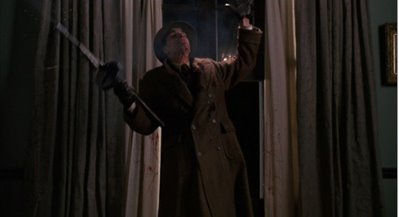
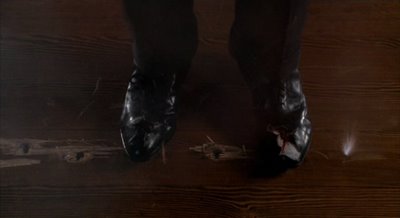

Obviously, the death of the goon in the window is complicated by the story. By virtue of his particular embroilment, the goon is not exempt, in Lichtenfeld's formula, from being an appropriate subject for a portrayal of violence. He tried to kill Leo; in turn, Leo kills him. He's fair game. However, the amount of time spent on the shooting of just that goon (twenty seconds, forever in movie time) and the detail that went in the sequence (i.e. the painting, the chandelier, and the shoes) are completely out of proportion to the significance of the character. Draw your own conclusion.
Another death in Miller's Crossing that I think is important is Eddie Dane's (J.E. Freeman). Here Johnny Caspar executes "the Dane" in his study.
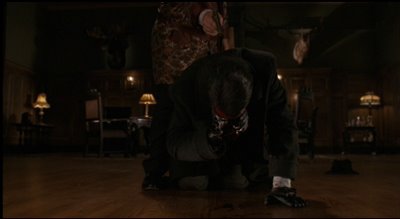
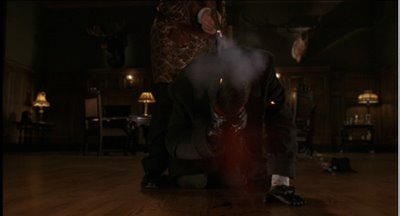
I wouldn't say that this shot is characteristic of the shootings in Miller's Crossing. There are several shots in which the Coen brothers cut away from the victim before or as the trigger is pulled, sparing the audience the sort of gruesomeness on display here. Moreover, the Dane is a villain who hounds Tom during the whole movie, so the level of gore at the end of the movie is appropriate. What is important to me about this shot is the position of the Dane's body, which reminds me of the Ridiculous Deaths of characters in two other Coen brothers movies.
In Blood Simple, Ray (John Getz) finds Marty (Dan Hedaya) with a bullet in his chest along with the weapon, a gun that belongs to Abby, Ray's lover and Marty's wife. Thinking that Abby shot Marty, and wanting to protect Abby, Ray takes Marty's body to a field to bury him. Here we see Marty, barely alive, try to escape.

The scene is particularly disturbing. Marty can barely drag himself along the road. His chest is covered with blood. He's almost dead. Ray gets in the car to run him over and decides against it. He gets a shovel out of the car and walks over to Marty, thinking he'll smash his head with it. He decides against that, too. Ultimately, Ray chooses to bury Marty alive.
In The Man Who Wasn't There, Big Dave Brewster (James Gandolfini) enacts another Ridiculous Death. Here we see his last moments alive. He is sinking into unconsciousness and death after Ed Crane severed his jugular vein with a small knife during a struggle. We hear him gurgling, presumably choking on his own blood, as he goes down.
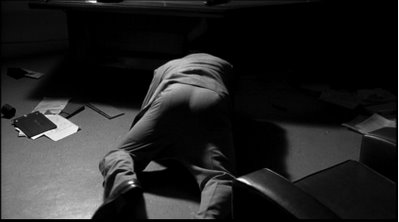
The Ridiculous Death: face-down, ass-up, going to the grave like a dog.
There are critics who see the cruelty here, although their emphasis is different than what I've talked about so far. Jane Dark calls a subset of the Coen brothers' movies a '"let's mock the rubes" cycle.' Jim Emerson recognizes that there's a bit shadenfruede at work in the Coen movies. Here he's addressing complaints by Christopher Hitchens and David Brooks about the sensibilities of Borat:
Both Hitchens and Brooks appear to have thought "Borat" was funny, but don't feel comfortable with that feeling. Laughing appears to have been a sin that requires some sort of confession. I have a feeling they would say the same things about Christopher Guest or Coen Bros. movies -- that they are about mocking, ridiculing, tearing down the characters so that the audience can feel superior. It does not seem to have occurred to either of them that it might be possible to laugh at -- even mock -- someone, while still feeling sympathy or even empathy. And that such feelings, as opposed to sheer derision, make the comedy even funnier.Going back to Kirkegaard, Emerson's argument implies that shadenfreude does not necessarily presume a metaphysical error. That is, contra Kirkegaard, shadenfreude can coexist with a unicity in which self and other are metaphysically one and the same. Watching someone else suffer, we identify with them and we laugh. This is possible because -- just like a person can laugh at their own pain when it has passed -- there's an ontological distance between us and, say, the mosquito bites on Barton Fink's face. The laughter is the same, the type of distance different.
Before I wrote this, I watched (again) all of the movies I cite. That process made me realize just how good the Coen brothers are. I used to love their movies, but watching them again after studying the art/craft of filmmaking for a year or so, some of them are absolutely breathtaking to me now. I'm still convinced of a particular lack of sympathy in the Coen brothers' body of work. Shadenfreude sums that up for me. Emerson's view of that, however, shows that there's more than one way to interpret the phenomenon of shadenfreude in their movies. Maybe I'll have more to say, or less, in the future; for now, I'm content.
John?

No comments:
Post a Comment